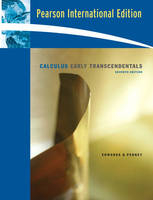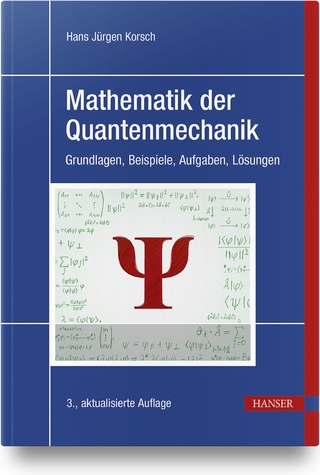
Calculus, Early Transcendentals
Pearson (Verlag)
978-0-13-615840-0 (ISBN)
- Titel erscheint in neuer Auflage
- Artikel merken
C. Henry Edwards is emeritus professor of mathematics at the University of Georgia. He earned his Ph.D. at the University of Tennessee in 1960, and recently retired after 40 years of classroom teaching (including calculus or differential equations almost every term) at the universities of Tennessee, Wisconsin, and Georgia, with a brief interlude at the Institute for Advanced Study (Princeton) as an Alfred P. Sloan Research Fellow. He has received numerous teaching awards, including the University of Georgia’s honoratus medal in 1983 (for sustained excellence in honors teaching), its Josiah Meigs award in 1991 (the institution’s highest award for teaching), and the 1997 statewide Georgia Regents award for research university faculty teaching excellence. His scholarly career has ranged from research and dissertation direction in topology to the history of mathematics to computing and technology in the teaching and applications of mathematics. In addition to being author or co-author of calculus, advanced calculus, linear algebra, and differential equations textbooks, he is well-known to calculus instructors as author of The Historical Development of the Calculus (Springer-Verlag, 1979). During the 1990s, he served as a principal investigator on three NSF-supported projects: (1) A school mathematics project including Maple for beginning algebra students, (2) A Calculus-with-Mathematica program, and (3) A MATLAB-based computer lab project for numerical analysis and differential equations students. David E. Penney, University of Georgia, completed his Ph.D. at Tulane University in 1965 (under the direction of Prof. L. Bruce Treybig) while teaching at the University of New Orleans. Earlier he had worked in experimental biophysics at Tulane University and the Veteran’s Administration Hospital in New Orleans under the direction of Robert Dixon McAfee, where Dr. McAfee’s research team’s primary focus was on the active transport of sodium ions by biological membranes. Penney’s primary contribution here was the development of a mathematical model (using simultaneous ordinary differential equations) for the metabolic phenomena regulating such transport, with potential future applications in kidney physiology, management of hypertension, and treatment of congestive heart failure. He also designed and constructed servomechanisms for the accurate monitoring of ion transport, a phenomenon involving the measurement of potentials in microvolts at impedances of millions of megohms. Penney began teaching calculus at Tulane in 1957 and taught that course almost every term with enthusiasm and distinction until his retirement at the end of the last millennium. During his tenure at the University of Georgia, he received numerous University-wide teaching awards as well as directing several doctoral dissertations and seven undergraduate research projects. He is the author or co-author of textbooks on calculus, computer programming, differential equations, linear algebra, and liberal arts mathematics.
TABLE OF CONTENTS
About the Authors
Preface
1 Functions, Graphs, and Models
1.1 Functions and Mathematical Modeling
Investigation: Designing a Wading Pool
1.2 Graphs of Equations and Functions
1.3 Polynomials and Algebraic Functions
1.4 Transcendental Functions
1.5 Preview: What Is Calculus?
REVIEW — Understanding: Concepts and Definitions
Objectives: Methods and Techniques
2 Prelude to Calculus
2.1 Tangent Lines and Slope Predictors
Investigation: Numerical Slope Investigations
2.2 The Limit Concept
Investigation: Limits, Slopes, and Logarithms
2.3 More About Limits
Investigation: Numerical Epsilon-Delta Limits
2.4 The Concept of Continuity
REVIEW – Understanding: Concepts and Definitions
Objectives: Methods and Techniques
3 The Derivative
3.1 The Derivative and Rates of Change
3.2 Basic Differentiation Rules
3.3 The Chain Rule
3.4 Derivatives of Algebraic Functions
3.5 Maxima and Minima of Functions on Closed Intervals
Investigation: When Is Your Coffee Cup Stablest?
3.6 Applied Optimization Problems
3.7 Derivatives of Trigonometric Functions
3.8 Exponential and Logarithmic Functions
Investigation: Discovering the Number e for Yourself
3.9 Implicit Differentiation and Related Rates
Investigation: Constructing the Folium of Descartes
3.10 Successive Approximations and Newton's Method
Investigation: How Deep Does a Floating Ball Sink?
REVIEW — Understanding: Concepts, Definitions, and Formulas
Objectives: Methods and Techniques
4 Additional Applications of the Derivative
4.1 Introduction
4.2 Increments, Differentials, and Linear Approximation
4.3 Increasing and Decreasing Functions and the Mean Value Theorem
4.4 The First Derivative Test and Applications
Investigation: Constructing a Candy Box With Lid
4.5 Simple Curve Sketching
4.6 Higher Derivatives and Concavity
4.7 Curve Sketching and Asymptotes
Investigation: Locating Special Points on Exotic Graphs
4.8 Indeterminate Forms and L'Hôpital's Rule
4.9 More Indeterminate Forms
REVIEW – Understanding: Concepts, Definitions, and Results
Objectives: Methods and Techniques
5 The Integral
5.1 Introduction
5.2 Antiderivatives and Initial Value Problems
5.3 Elementary Area Computations
5.4 Riemann Sums and the Integral
Investigation: Calculator/Computer Riemann Sums
5.5 Evaluation of Integrals
5.6 The Fundamental Theorem of Calculus
5.7 Integration by Substitution
5.8 Areas of Plane Regions
5.9 Numerical Integration
Investigation: Trapezoidal and Simpson Approximations
REVIEW — Understanding: Concepts, Definitions, and Results
Objectives: Methods and Techniques
6 Applications of the Integral
6.1 Riemann Sum Approximations
6.2 Volumes by the Method of Cross Sections
6.3 Volumes by the Method of Cylindrical Shells
Investigation: Design Your Own Ring!
6.4 Arc Length and Surface Area of Revolution
6.5 Force and Work
6.6 Centroids of Plane Regions and Curves
6.7 The Natural Logarithm as an Integral
Investigation: Natural Functional Equations
6.8 Inverse Trigonometric Functions
6.9 Hyperbolic Functions
REVIEW – Understanding: Concepts, Definitions, and Formulas
Objectives: Methods and Techniques
7 Techniques of Integration
7.1 Introduction
7.2 Integral Tables and Simple Substitutions
7.3 Integration by Parts
7.4 Trigonometric Integrals
7.5 Rational Functions and Partial Fractions
7.6 Trigonometric Substitutions
7.7 Integrals Involving Quadratic Polynomials
7.8 Improper Integrals
SUMMARY — Integration Strategies
REVIEW – Understanding: Concepts and Techniques
Objectives: Methods and Techniques
8 Differential Equations
8.1 Simple Equations and Models
8.2 Slope Fields and Euler's Method
Investigation: Computer-Assisted Slope Fields and Euler's Method
8.3 Separable Equations and Applications
8.4 Linear Equations and Applications
8.5 Population Models
Investigation: Predator-Prey Equations and Your Own Game Preserve
8.6 Linear Second-Order Equations
8.7 Mechanical Vibrations
REVIEW — Understanding: Concepts, Definitions, and Methods
Objectives: Methods and Techniques
9 Polar Coordinates and Parametric Curves
9.1 Analytic Geometry and the Conic Sections
9.2 Polar Coordinates
9.3 Area Computations in Polar Coordinates
9.4 Parametric Curves
Investigation: Trochoids Galore
9.5 Integral Computations with Parametric Curves
Investigation: Moon Orbits and Race Tracks
9.6 Conic Sections and Applications
REVIEW – Understanding: Concepts, Definitions, and Formulas
Objectives: Methods and Techniques
10 Infinite Series
10.1 Introduction
10.2 Infinite Sequences
Investigation: Nested Radicals and Continued Fractions
10.3 Infinite Series and Convergence
Investigation: Numerical Summation and Geometric Series
10.4 Taylor Series and Taylor Polynomials
Investigation: Calculating Logarithms on a Deserted Island
10.5 The Integral Test
Investigation: The Number p, Once and for All
10.6 Comparison Tests for Positive-Term Series
10.7 Alternating Series and Absolute Convergence
10.8 Power Series
10.9 Power Series Computations
Investigation: Calculating Trigonometric Functions on a Deserted Island
10.10 Series Solutions of differential Equations
REVIEW — Understanding: Concepts, and Results
Objectives: Methods and Techniques
11 Vectors, Curves, and Surfaces in Space
11.1 Vectors in the Plane
11.2 Three-Dimensional Vectors
11.3 The Cross Product of Two Vectors
11.4 Lines and Planes in Space
11.5 Curves and Motion in Space
Investigation: Does a Pitched Baseball Really Curve?
11.6 Curvature and Acceleration
11.7 Cylinders and Quadric Surfaces
11.8 Cylindrical and Spherical Coordinates
REVIEW – Understanding: Concepts, Definitions, and Results
Objectives: Methods and Techniques
12 Partial Differentiation
12.1 Introduction
12.2 Functions of Several Variables
12.3 Limits and Continuity
12.4 Partial Derivatives
12.5 Multivariable Optimization Problems
12.6 Increments and Linear Approximation
12.7 The Multivariable Chain Rule
12.8 Directional Derivatives and the Gradient Vector
12.9 Lagrange Multipliers and Constrained Optimization
Investigation: Numerical Solution of Lagrange Multiplier Systems
12.10 Critical Points of Functions of Two Variables
Investigation: Critical Point Investigations
REVIEW — Understanding: Concepts, Definitions, and Results
Objectives: Methods and Techniques
13 Multiple Integrals
13.1 Double Integrals
Investigation: Midpoint Sums Approximating Double Integrals
13.2 Double Integrals over More General Regions
13.3 Area and Volume by Double Integration
13.4 Double Integrals in Polar Coordinates
13.5 Applications of Double Integrals
Investigation: Optimal Design of Race Car Wheels
13.6 Triple Integrals
Investigation: Archimedes' Floating Paraboloid
13.7 Integration in Cylindrical and Spherical Coordinates
13.8 Surface Area
13.9 Change of Variables in Multiple Integrals
REVIEW – Understanding: Concepts, Definitions, and Results
Objectives: Methods and Techniques
14 Vector Calculus
14.1 Vector Fields
14.2 Line Integrals
14.3 The Fundamental Theorem and Independence of Path
14.4 Green's Theorem
14.5 Surface Integrals
Investigation: Surface Integrals and Rocket Nose Cones
14.6 The Divergence Theorem
14.7 Stokes' Theorem
REVIEW — Understanding: Concepts, Definitions, and Results
Objectives: Methods and Techniques
Appendices
A: Real Numbers and Inequalities
B: The Coordinate Plane and Straight Lines
C: Review of Trigonometry
D: Proofs of the Limit Laws
E: The Completeness of the Real Number System
F: Existence of the Integral
G: Approximations and Riemann Sums
H: L'Hôpital's Rule and Cauchy's Mean Value Theorem
I: Proof of Taylor's Formula
J: Conic Sections as Sections of a Cone
K: Proof of the Linear Approximation Theorem
L: Units of Measurement and Conversion Factors
M: Formulas from Algebra, Geometry, and Trigonometry
N: The Greek Alphabet
Answers to Odd-Numbered Problems
References for Further Study
Index
| Erscheint lt. Verlag | 5.4.2007 |
|---|---|
| Sprache | englisch |
| Maße | 204 x 283 mm |
| Gewicht | 2350 g |
| Themenwelt | Mathematik / Informatik ► Mathematik ► Analysis |
| ISBN-10 | 0-13-615840-4 / 0136158404 |
| ISBN-13 | 978-0-13-615840-0 / 9780136158400 |
| Zustand | Neuware |
| Haben Sie eine Frage zum Produkt? |
aus dem Bereich



